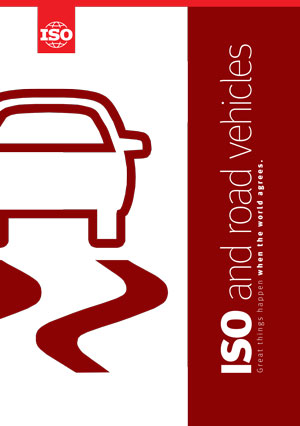"Clearly, with more than a billion estimated road vehicles in use worldwide," the brochure states, "if the automotive sector uses state-of-the-art standards for aspects such as safety, impact on the environment, and requirements for supply chain partners, this can have an enormous impact on all three dimensions of sustainable development – social, environmental and economic.
"The importance of this challenge is reflected by ISO's response. Out of a current total of nearly 19 000 ISO International Standards for almost all sectors of business and technology, some 900 have been developed for road vehicles and related technologies."
ISO standards provide benefits for manufacturers and supply chain partners; regulators and health authorities; vehicle owners and drivers, and road users including pedestrians. They cover all aspects of road vehicles: safety, ergonomics, performance, test methods, the environment, and the roll-out of innovative technologies.
The focus of much of this work is ISO technical committee ISO/TC 22, Road vehicles, which has so far developed more than 700 standards and updates. These range from standards addressing basics such as wheels, braking systems and road holding ability, to crash protection, child restraint systems and ergonomics. Many aim to improve compatibility, interchangeability and safety, or to provide the requirements for harmonized test procedures for evaluating performance.
Its standards address road vehicles from mopeds, through cars to articulated good vehicles. Twenty-six countries participate in developing standards within the committee, with another 41 as observers. Other contributors include automotive sector associations and international bodies such as the World Health Organization.
Increasingly, road vehicles are integrated with systems and networks based on information and communication technologies with varied objectives such as safety, traffic control, navigation, fee collection and identification. Today’s communications capabilities give the potential for vehicles to foresee and avoid collisions, transmit their position to emergency services in case of an accident, navigate the quickest route to their destination, make use of up-to-the-minute traffic reports, identify the nearest available parking slot, minimize their carbon emissions and provide multimedia communications.
ISO/TC 204, Intelligent transport systems, is the principal focus in this area and has developed more than 110 standards and updates. Twenty-six countries participate with another 24 as observers.
ISO/TC 31, Tyres, rims and valves, has developed some 75 standards and updates. Twenty-one countries participate with another 26 as observers.
The technical specification ISO/TS 16949 has become the global benchmark for quality management by automotive suppliers. Certification of conformity to ISO/TS 16949 is often required of suppliers by the automobile manufacturers as a condition to tender for participation in global supply chains. Up to the end of December 2010, at least 43 946 ISO/TS 16949:2002 certificates, a growth of 7 %, had been issued in 84 countries and economies. The document is the work of ISO/TC 176, Quality management and quality assurance.
The future ISO 39001, Road-traffic safety management systems, being developed by ISO project committee ISO/PC 241, Road safety management, is widely regarded as a major contribution to the United Nations' Decade of Action for Road Safety 2011-2020.
ISO standards now under development address alternative power systems promising less pollution and therefore contributing to the fight again climate change. These include standards for electrically propelled vehicles and vehicles powered by gaseous fuels, as well as for the infrastructures necessary to support them.
To prepare the future of road vehicles, ISO works closely with its partners of the World Standards Cooperation (WSC) – the International Electrotechnical Commission (IEC) and the International Telecommuncation Union (ITU). For example, in March 2012 at the Geneva International Motor Show, Switzerland, the three organizations will host the seventh edition of the Fully Networked Car workshop on the car of the future and the ITS needed to support it.
The brochure, ISO & road vehicles, published in English and French, is available free of charge from the ISO Central Secretariat through the ISO Store or by contacting the Marketing, Communication & Information department. It can also be obtained from ISO national member institutes (see the complete list with contact details).
ISO standards share state-of-the-art technology and good practice with the automotive sector worldwide. Nearly 900 ISO standards have been developed for road vehicles and related technologies.

